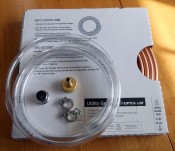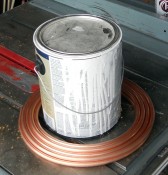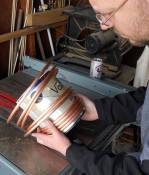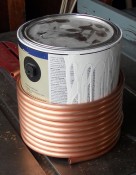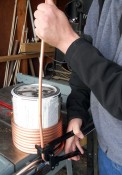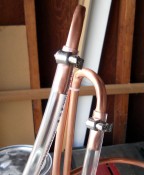Last Sunday, I went back to Montana Fair too get my feedback on the beer I submitted for the homebrew competition. As far as placing, here are my results:
- Lawnmower Man (Cream Ale): White Ribbon (3rd) – Against 2 other entries.
- Dishwater Wheat (American Wheat): Red Ribbon (2nd) – Up against 1 other entry (nobody placing 1st? Strange.)
- Zuul Drool (Brown Ale): White Ribbon (3rd) – Against 2 other entries.
It was neat to win a ribbon. But then again, I wasn’t up against many others in any one category/style. So I can keep the ego in check. What I was really interested in is the feedback. The judges used the AHA standards when judging the beer, however, I don’t think this was an official AHA event. I’m not even sure if the judges were AHA certified judges. But I’m certain that these judges know beer better than I do, and I’m definitely interested in what they have to say.
After I got the results, few guys from work and I opened a couple bottles of each to see if we can taste what they’re tasting. So, following the judges feedback, I’ve also included my own comments.
Lawnmower Man (Cream Ale)
- Bottle Inspection:
- Bouquet/Aroma:
- 10/10 – Faint malt notes. No hops aroma. Well balanced.
- 6/10 – Faint maltyness. Good to style. No hops. Right on veggie smell.
- Appearance:
- 2/6 – Far too dark for style. Style must be sparkling clear. Fair head retention, true to style.
- 2/6 – Color too dark. Should be straw to pale gold. Cloudy. Should be sparkling clear.
- Flavor:
- 10/19 – DMS flavor is very present. Style allows some but this is too much. Balance is decent.
- 8/19 – Tastes very veggie flavor. Canned corn (DMS)
- Body:
- 3/5 – Thin style. Decent for style.
- 5/5 – Right on thin. Could be med body.
- Drinkability & Overall Impression:
- 6/10 – Not Enjoyable. Too much DMS flavor present. Aroma is true to style.
- 4/10 – Not very drinkable to my tastes.
- Total/Score Guide:
- 31 – Very Good (30-39). Exemplifies style well, requires some attention.
- 25 – Good (20-24). Exemplifies style satisfactorily, but requires attention.
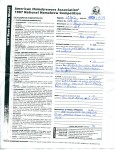
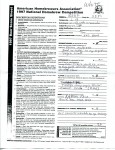 My Comments:
My Comments:
This is an older beer, but it should still be good at this point (even for a light beer). I think I brewed it in May. After tasting, I do taste a vegetable taste. The color is admittedly way off. This recipe has unusual malts for a Cream Ale, which made it darker. The beer is very cloudy, mostly due to yeast sediment. I think this was before I was using Wirlflock. This beer did not age well.
Dishwater Wheat (American Wheat)
- Bottle Inspection:
- Bouquet/Aroma:
- 8/10 – Rye Evident
- 8/10 – Nice bouquet for the style. Slightly cloved and appropriate in tolerance for style.
- Appearance:
- 4/6 – Color good. Slightly cloudy (Rye or chill haze?)
- 5/6 – Color good to style. Blond & Clear. Pleasant.
- Flavor:
- 15/19 – Somewhat estery. Rye and hops evident, but not over.
- 14/19 – Good flavor. Mouthfeel is a little low on carbonation.
- Body:
- 3/5 – Perhaps a little lite on body.
- 4/5 – Body is correct to style.
- Drinkability & Overall Impression:
- 7/10 – Nice summer beer. Very good effort. Enjoyable.
- 9/10 – Good summertime quencher. Enjoyable overall. Pleasant.
- Total/Score Guide:
- 37/50 – Very Good (30-39). Exemplifies style well, requires some attention.
- 40/50 – Excellent (40-50) Exceptionally exemplifies style. Requires little or no attention.
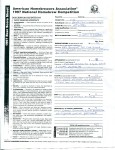
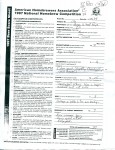 My Comments:
My Comments:
This one is kinda interesting. First, the judge tasted Rye, which isn’t present at all. This is an American Wheat. One said it was cloudy and the other said it was clear. I actually like it a bit cloudy (hence the name, Dishwater Wheat), which is appropriate for a wheat beer.
One judge said it was estery, which I might have to agree with. While wheat beers do have a hint of fruit, I used a clean ale yeast, so this should be pretty minimal. I’m guessing it fermented too warm (68 degrees ambient, so fermentation could be as high as 72).
One said it was a little light on the body, which I might agree with. The other said it was on-style. Next time I’ll try to boost the body a bit. I also want to increase the haziness. I really like the color and the association of dirty water for this beer. Call me strange, but it has a really neat look.
Zuul Drool (Northern Brown Ale)
- Bottle Inspection:
- Bouquet/Aroma:
- 5/10 – Aroma is slightly off style. Too light with not enough malt character.
- 7/10 – Aroma OK.
- Appearance:
- 5/6 – Head correct in style & appearance. Color good & clean.
- 4/6 – Good color for Northern Brown. Good retention & color head.
- Flavor:
- 12/19 – Flavor is pleasant at first, but disappears leaving a severe bitter aftertaste not common to style. Balance is not present as malt is prevalent at beginning [handwriting is unreadable…guessing its beginning].
- 12/19 – Some kind of aftertaste that detracts from overall enjoyment.
- Body:
- 3/5 – Body thin for style
- 2/5 – Thin body.
- Drinkability & Overall Impression:
- 6/10 – Not bad, but weak for the style.
- 7/10 – Quite drinkable, but needs work. Slightly oxidized. Try to be a little more careful when bottling.
- Total/Score Guide:
- 31/50 – Very Good (30-39). Exemplifies style well, requires some attention.
- 32/50 – Very Good (30-39). Exemplifies style well, requires some attention.
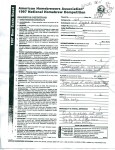
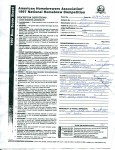 My Comments:
My Comments:
These responses I’ll have to agree with. I was never very happy with this recipe. My first Zuul Drool (all extract) was much more enjoyable. I felt this was thin with a bitter aftertaste. The malt really wasn’t there to back up the coffee flavor (which I’m attributing to the bitterness they’re tasting). The beer looked the look, but didn’t deliver in taste. They also mention it was a bit oxidized. I think I can taste that now they pointed it out. I’m not sure where the oxidization would happen, though. My bottling and racking procedures seems to be proper. This one is a mystery to me.
Zuul Drool Label
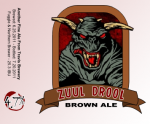 Appearance:
Appearance:- Content:
- Originality:
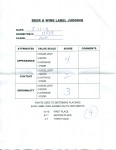
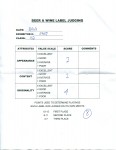 My Comments:
My Comments: I really enjoy coming up with names and labels for my beer. I normally use only a 1×2 5/8″ label on my beer. Since I’m pretty decent at Photoshop, I can whip up a quick illustration/logo and include info such as AVB, IBU, hops used, brewing date, and bottling date. While I go a little further with “branding” my beer, I don’t spend too much time designing a label (about 1/2 hour or less). So, considering the effort I put into the label, I pretty happy with the results of the label contest.














 Rogue Demon Hunter
Style: 8-A Standard/Ordinary Bitter
Type: Brew In A Bag (BIAB)
Batch: #9
Size: 5.0 gal
Calories: 127.9 kcal per 12.0 fl oz
Rogue Demon Hunter
Style: 8-A Standard/Ordinary Bitter
Type: Brew In A Bag (BIAB)
Batch: #9
Size: 5.0 gal
Calories: 127.9 kcal per 12.0 fl oz
